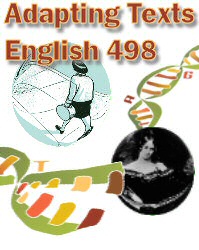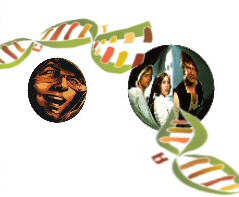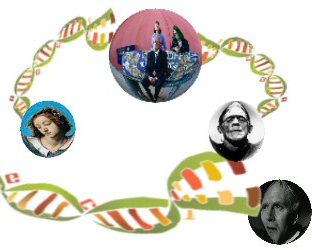|
|
Critical Adaptation Project Grading
An 88- to 100-Point Project (3.5-4.0, A Range)
- Creative component engages in complex, rich dialogue with source and selected adaptations; writer’s adaptation offers an innovative perspective on its textual influences.
- Adaptation presents compelling plot, characterization, themes, motifs, imagery, description, and/or other details.
- Critical introduction offers defendable, substantive, fully explored and persuasively supported discussion of project’s relationship to source, other adaptations, and adaptation theory.
- All elements of site express ideas clearly and command the reader’s attention.
- Organization advances the author’s creative goals; the relationship among pages is clear, and all navigation elements function.
- Includes all required elements: critical introduction, adaptation, and annotated sources, links and credits.
- Integrates text and audio-visual elements thoughtfully, with all images, links, and clips clearly complementing the creative work and critical introduction.
- Offers clear citation of all ideas and words not the author’s own.
- Has superlative page design: easily viewable text and images, skillful use of color, no clutter.
- Has a sophisticated style (remarkable variety of sentence pattern, smooth transitions between ideas, superior control of diction).
- Has few, if any, minor errors in grammar, usage or mechanics.
A 63- to 87-Point Project (2.5-3.4, B Range)
- Creative component effectively engages in dialogue with source and selected adaptations; at points, writer’s work may rely too heavily on other adaptations; however, it offers many fresh perspectives on its textual precursors.
- While the adaptation may include a few formulaic components, as a whole it features engaging plot, characterization, themes, motifs, imagery, description, and/or other details.
- Critical introduction persuasively discusses project’s relationship to source, other adaptations, and adaptation theory, but may not fully explore or support ideas; references to theory may seem tacked on rather than closely connected to the author’s claims.
- All elements of site express idea clearly.
- Site organization has clear relationship to author’s creative goals; however, a few navigation elements may not function or may be absent, or a particular page may not completely advance the project’s stated purpose.
- Includes all required elements: “About this Site,” analysis, and annotated sources, links and credits.
- Integrates text and audio-visual elements effectively overall, although relationship between these components may be unclear on occasion.
- Properly cites source material, but may have errors in citation format.
- Has strong page design: clear text and images, effective use of color, minimal clutter.
- Has an effective style (some variety of sentence patterns, transitions between ideas, accurate diction).
- Has few errors in grammar, usage or mechanics.
A 38- to 62-Point Project (1.5-2.4, C Range)
- Creative component engages in dialogue with source and selected adaptations; overall, writer’s work may rely too heavily on other adaptations rather than offering new perspectives on its textual precursors.
- Adaptation presents formulaic or simplistic plot, characterization, themes, motifs, imagery, description, and/or other details.
- Critical introduction includes unevenly developed discussion of project’s relationship to source and other adaptations and demonstrates little engagement with adaptation theory, offering a few citations of theoretical texts, but not tying the references to the analysis in a clear manner.
- Communicates ideas clearly for the most part, but may have some lapses in clarity.
- Has an organizational pattern discernibly based on author’s creative goals, but navigation may be confusing, and some pages may not fit site’s overall purpose.
- Contains the creative adaptation and critical introduction, but annotated links and credits section may not include annotations or required minimum number of links.
- Integrates text and audio-visual elements throughout the site, but without consistently demonstrating a connection between these elements.
- Cites the majority of source material, but occasionally material may be clearly cited but not referenced in parentheses.
- Has adequate page design: satisfactory text and images, adequate use of color, some page clutter.
- Has an adequate style (limited variation in sentence patterns, transitions between most ideas, diction accurate for the most part).
- Has some errors in grammar, usage or mechanics, but demonstrates basic control of these areas.
An 18- to 37-Point Project (.7-1.4, D Range)
- Creative component demonstrates no meaningful dialogue with the source and other adaptations; writer draws on plot events or echoes prose of other adaptations, but offers no interpretation or reworking of its textual influences.
- Adaptation presents stereotypical or confusing plot, characters, imagery, and/or other details.
- Critical introduction identifies the source and other adaptations without sufficiently connecting the project to those texts; discussion indicates misunderstanding of adaptation theory, including references that have no discernible relationship to the writer’s project.
- May not communicate ideas clearly.
- Is ineffectively organized, with no logical relationship among pages and unclear navigation.
- Contains creative adaptation, but is missing one required section of site.
- Uses text and audiovisual elements, but with little connection between the two.
- Offers unclear citations of work not the author’s own.
- Has weak page design: some confusing text and images, poor use of color (glaring), page clutter.
- Has stylistic weaknesses (no variety of sentence patterns, few transitions, imprecise diction).
- Has occasional major errors in grammar, usage or mechanics or frequent minor errors that interfere in the reader's understanding of the analysis.
A 0- to 17-Point Project (0-.6, F Range)
- Project may be deliberately off-topic, with both the creative adaptation and critical introduction demonstrating no engagement with or understanding of the source, other adaptations, or adaptation theory.
- Does not communicate ideas clearly.
- Lacks coherent organization, site is difficult or impossible to navigate.
- Creative adaptation is brief, and other site elements may be absent or entirely inadequate.
- Has no connection between text and audiovisual elements.
- Represents another writer’s work as the author’s own.
- Has incoherent page design: unclear text and images, no sense to color choice, clutter makes page incomprehensible.
- Has an incoherent style (difficulties with sentence structure, pattern of diction errors).
- Has pervasive pattern of errors in grammar, usage and mechanics that renders the analysis unreadable.
Last Update: 6/6/06
|



